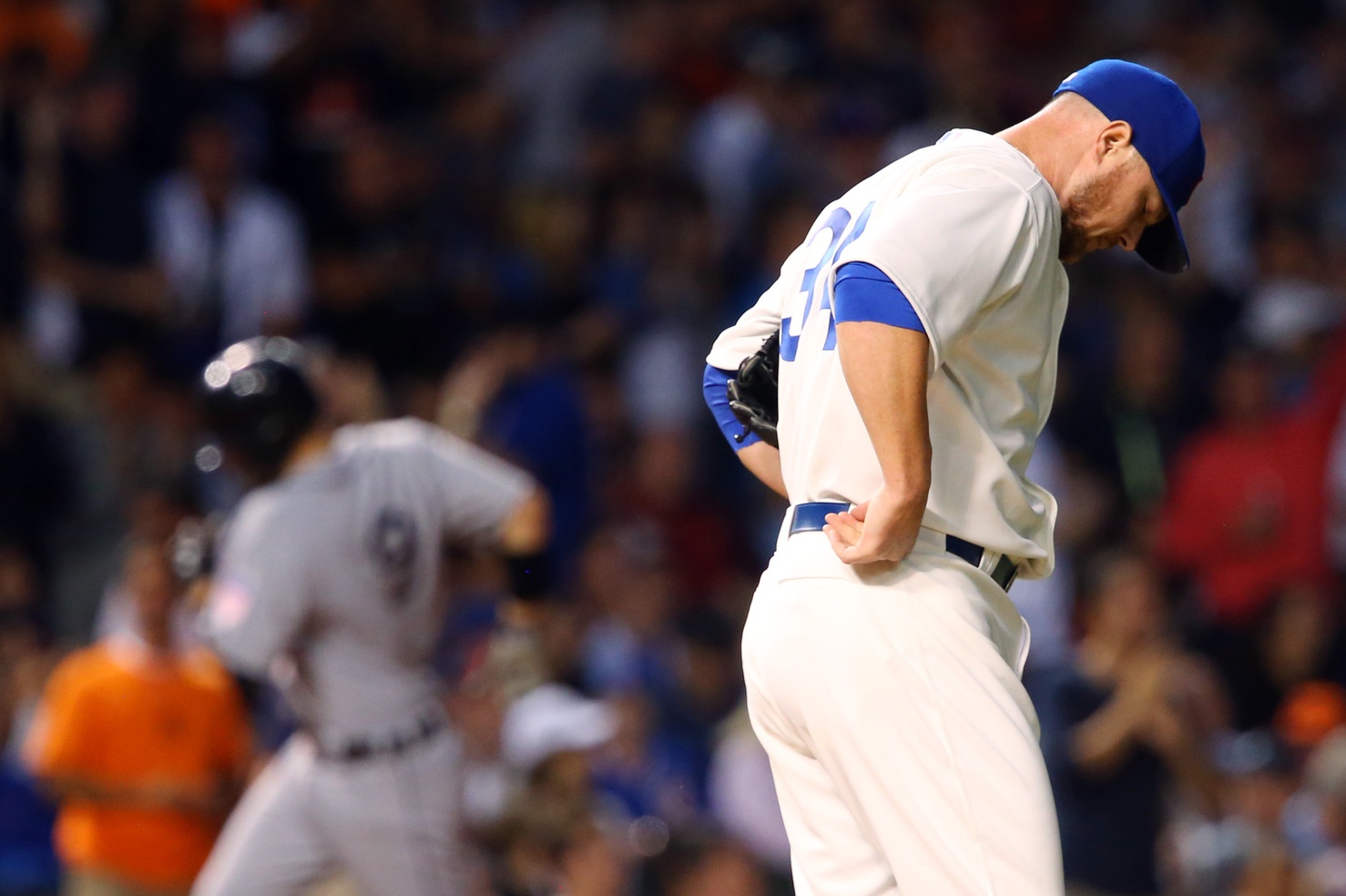Introduction
Well, damnit. As a man wiser and more fictitious than myself once said, “Sometimes you eat the bear…and sometimes the bear eats you.”* On Wednesday night at Wrigley Field, the bear, or Tiger, ate Lester.
*Have any of you seen The Big Lebowski? It’s obscure, but I’m a bit of an indy film nerd, so that’s why I know the quote. Or, I was in college for more than five seconds in the 2000s.
Against the Detroit Tigers, Lester’s remarkable two month stretch came to an abrupt and definite end. After a marvelous 11-start run in which he posted a 2.20 ERA, 0.937 WHIP, 27.9 percent strikeout rate, and surrendered just two home runs, he struggled to keep the ball in the park and throw his fastballs past Tigers hitters.
In fact, Lester’s start against Detroit was so subpar, it set several dubious career marks:
- The 62 pitches is the fewest Lester had thrown in a start since he threw 55 on September 24, 2011 against the New York Yankees, a span of 124 regular season starts.
- The 2 2/3 innings pitched was his shortest start since April 17, 2012, when he went two innings against the Texas Rangers.
- The three home runs was the most home runs he has surrendered since he allowed four on July 22, 2012 against the Toronto Blue Jays.
- Of the 159 regular season home runs Lester has now surrendered, Daniel Morris was the first pitcher (see Key At-Bat/Sequence section) to homer off of him.
- Lester’s Game Score of 17 is his lowest since he posted a 16 at the Tampa Bay Rays on June 11, 2013.
On Wednesday, the Tigers were extremely patient against Lester, swinging at just three of 17 first pitches. Lester got ahead of just 47.1 percent of batters (8 of 17), his lowest percentage since April. He induced just five whiffs on the night (two from fastballs), his lowest total of the season. His four-seam fastball was tagged for a double and a home run, and it has been hit hard in August.
In the season’s second half, the Tigers were hitting just .250/.305/.403 with a 22.4 percent strikeout rate and a 7.1 percent walk rate entering the game. No offense in baseball has had more success with balls in play, as the Tigers entered Wednesday with major league best .325 BABIP. However, the team had been hitting better with the return of Miguel Cabrera, scoring 27 runs in their previous five games. They also remained in the top five in the American League in runs scored, on-base percentage, slugging percentage, and OPS.
The offense is led by players who seem to relish the opportunity to face Lester, including Miguel Cabrera (.533/.659/.767), Ian Kinsler (.270/.325/.486), and Nick Castellanos (three homes in nine plate appearances). As you can see, the entire Tigers offense has had little trouble with Lester in 2015:
| Innings Pitched | ERA | WHIP | Batter’s Faced | Hits | Walks | Extra-Base Hits | AVG | OBP | SLP |
| 7.0 | 15.43 | 3.00 | 40 | 16 | 5 | 8 | .457 | .525 | .775 |
Most amazingly to me, 21 of 40 Tigers batters to face Lester have reached base. After Lester faced the Tigers on June 9th, we solemnly wrote the words below, and much of it applies to Wednesday night:
This one was ugly, no matter the numbers you want to dissect. Lester lasted 4 1/3 innings, matching his season low from Opening Night against the St. Louis Cardinals. His 11 baserunners allowed was a season-high. Lester struggled to get ahead of Tigers hitters, as his 54.6 percent first-pitch strike rate (12 of 22), was his lowest rate since his fourth start of the season. And after Tuesday night, Lester has now allowed at least five earned runs in consecutive starts for the first time since June 2013.
The 31-pitch fourth inning made it the third consecutive start that Lester has had a 30 pitch inning, after having none in his first nine starts. In the fourth and fifth innings, Lester surrendered seven hits and two walks in the span of 11 batters. As you can see below, in those two innings the Tigers did much of their damage when Lester was up and out over the plate:
Lester, in 2015 especially, cannot figure out the Detroit Tigers. There are very few positive ways you can break down Lester’s 24th start of the season. So, let’s just get down to it and find out what went so wrong.
Traditional Line
2.2 IP, 7 H, 4 K, 3 BB, 7 ER
Pitch Breakdown
62 pitches (34 strikes)
| Total | Velocity (Max) | AVG | SLG | BABIP | |
| Four-Seam | 35 | 93.0 (94.4) | .429 | 1.000 | .400 |
| Cutter | 10 | 89.2 (91.3) | .000 | .000 | .000 |
| Sinker | 4 | 92.4 (93.4) | .667 | 1.667 | 1.000 |
| Change-Up | 1 | 85.5 (85.5) | .000 | .000 | .000 |
| Curveball | 10 | 77.4 (78.9) | .250 | 1.000 | .000 |
At the risk of continuing to beat an extremely beaten point, Wednesday night was ugly for Lester. He gave up home runs on three different pitches, and struggled to throw strikes consistently with any of his pitches. In the first inning, Lester lived off the plate, and while he did pick up five called strikes on pitches outside the strike zone, Tigers hitters were not chasing:
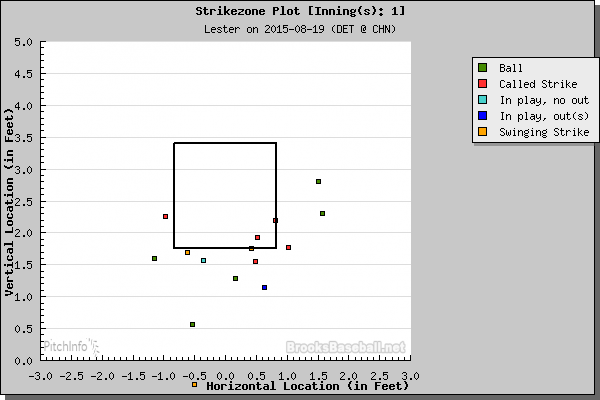
In the second and third inning, the Tigers again laid off pitches off the plate (Lester threw just 22 strikes on 45 pitches), and did all their damage when Lester fell behind and came back over the plate:
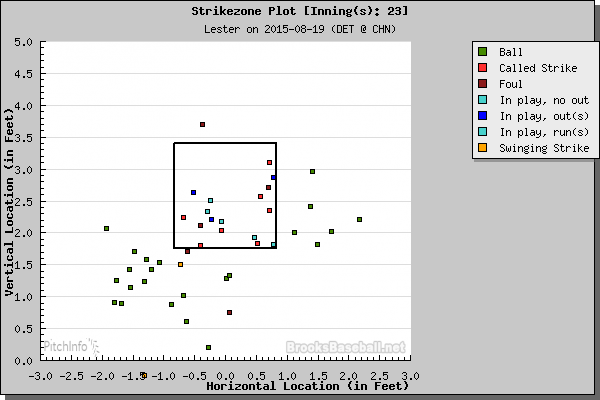
Entering the game, the Tigers had the lowest swing rate in the AL (49.7 percent).
Lester went to his four-seamer 56.5 percent of all pitches, his highest frequency in 2015. However, he induced just one whiff with the fastball. Lester gave up his eighth home run of the year off his four-seamer. In August, Lester has gone to his four-seamer 44.53 percent of all pitches, with the greatest frequency of any month, and opposing batters are hitting .400 and slugging .650 (see Trends section).
Lester surrendered his first home run of the season off his sinker (see Key At-Bat/Sequence section), but the pitch was well executed throughout the night. After going to his sinker 13 percent of all pitches in his final five starts of July, he has gone to just 9.1 percent of the time in August.
Lester used his curve to pick two of his four strikeouts, and three of his five whiffs. Unfortunately, Castellano’s second home run of the game was off a 76 mph curveball. It was Castellano’s first career extra-base hit off a curve from a left-handed pitcher, making it another case of good pitch selection by Ross, but less than desirable results. Otherwise, Lester’s curve remained its usual dominant self in 2015.
Trends
In recapping Lester’ previous start against the Milwaukee Brewers, we detailed his recent reticence to go to his four-seamer with two strikes:
Lester threw his highest frequency of four-seam fastballs since June 9th at Detroit…However, of Lester’s 13 strikeouts in his past two starts, just one has come via the four-seamer. While his average velocity with the four-seamer in the two starts (92.99 mph) has been above his season average (92.68 mph), his two-strike usage has dropped significantly.
Has Lester, at least momentarily, lost his confidence to put away hitters with his four-seamer?
In his past three starts, just two of 17 strikeouts (11.8 percent) have come via the four-seamer. That is below both his season average (61.4 percent) and career average (32.7 percent) entering August. In fact, as the season has progressed, Lester’s four-seamer has been accounting for fewer strikeouts, while his frequency and velocity have remained relatively stable:
| Month | Frequency of Pitch | Velocity (MPH) | Percentage of Strikeouts |
| April | 39.84% | 92.32 | 47.8% |
| May | 41.42% | 93.08 | 43.2% |
| June | 44.14% | 92.83 | 38.1% |
| July | 38.91% | 92.38 | 28.0% |
| August | 44.53% | 92.99 | 11.8% |
Lester’s four-seam usage with two strikes has been up and down all season, but has hit a season low in August:
| Month | vs. LHH | vs. RHH |
| April | 49.0% | 40.0% |
| May | 18.0% | 44.0% |
| June | 35.0% | 39.0% |
| July | 43.0% | 30.0% |
| August | 18.0% | 21.0% |
As Lester’s four-seam strikeout rates and usage with two strikes has decreased, Lester has increased slightly his curveball frequency, but he has seen a significant leap in strikeouts off the pitch:
| Curve | Pitch Frequency % | Percentage of Strikeouts |
| Starts 1-21 | 15.58% | 26.7% |
| Starts 22-24 | 17.74% | 41.2% |
| Career | 15.49% | 25.9% |
Early in the season, we
Key At-Bat/Sequence
Inning: Second Inning
Score: 1-0, Tigers leading
Situation: Aaron Gose on first base
Batter(s): Daniel Norris
Lester lived dangerously in the first inning, giving up a one-out double to Kinsler on a 92 mph four-seamer, before getting out of the inning unscathed.
Castellanos led off the second inning, and after Lester fell behind 1-and-0 on a four-seamer that missed low (a re-occurring theme) Lester surrendered a home run to Castellanos on a 92 mph sinker over the outside edge of the plate:

While it might seem like the fastball caught too much of the plate, Lester actually located the pitch in a spot where Castellanos had done very little against sinkers until last night:
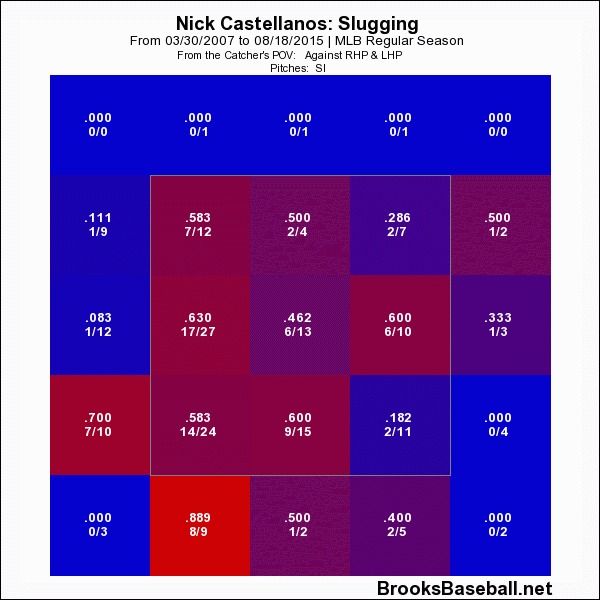
Lester attacked Norris—a 22-year-old pitcher who had not batted since high school—exactly as you might expect: simply, with all four-seam fastballs After falling behind 1-and-0, Lester came back with a four-seamer to even the count. On 1-and-1, he left a 94 mph four-seamer up and over the plate:
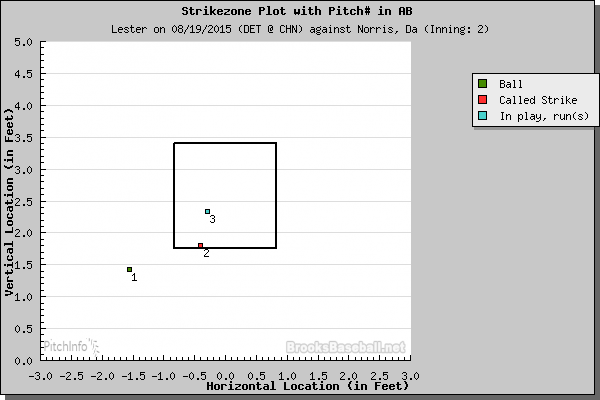
Lester missed Ross’ target down and away, and the ball landed a good distance beyond the centerfield wall. It was that kind of night for Lester, falling behind early with fastballs, and then when he does come over the plate, the ball carrying out of the stadium. Lester surrendered his first home run ever to a pitcher, and things would just get uglier.
Keep-In-Mind
In 11 career starts against the Tigers, Lester is now 2-6 with a 6.05 ERA and 1.803 WHIP. Nearly every pitcher, though, no matter their level of greatness, has a team against which they struggled. For example, in 20 career starts against the Arizona Diamondbacks, Greg Maddux went 3-11 with a 5.37 ERA and 1.555 WHIP.**
The Tigers have been an excellent offensive team since Lester arrived in the majors in 2006, so it is not as if he is the only good pitcher they have hit hard. And barring a miraculous next two months for both teams, he will not face Detroit again this season. While the recent four-seam struggles are cause for concern, Lester’s numbers against the Tigers are no reason to panic.
**As fellow baseball-obsessed curmudgeons, you are no doubt pointing out that the Arizona Diamondbacks did not begin play until 1998, right as Maddux was nearing the end of his brilliant peak. However, in his final 11 seasons, when he made all 20 starts against Arizona, Maddux posted a 3.53 ERA, 1.168 WHIP, and 122 ERA+. It was not peak Maddux, but it damn near qualifies as peak everybody else.
Conclusion
One disastrous start does not undo a brilliant two month stretch in which Lester pitched like a staff ace and helped the Cubs ascend to the thick of the NL playoff race. On a windy night on the lake, the Tigers were patient, put the ball in play against his fastballs, and did damage against two pitches (curve and sinker) with which Lester has had considerable success this season. In the course of 32-33 starts, these nights happen. As he has this season after his miserable April and poor first half of June, I expect Lester to rebound and continue takin ‘er easy for all us sinners. Lester abides.***
***I’m sorry. I’ll show myself out.
Season to Date
8-9, 3.58 ERA (4.23 DRA), 1.227 WHIP, 24.8% K, 6.3% BB
Lead photo courtesy of Jerry Lai-USA TODAY Sports
